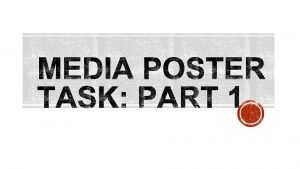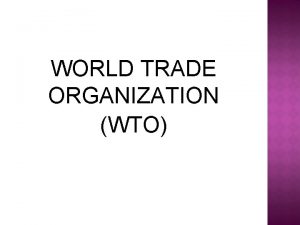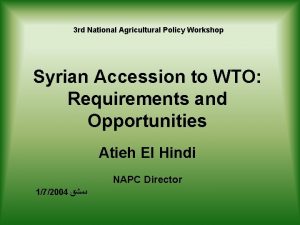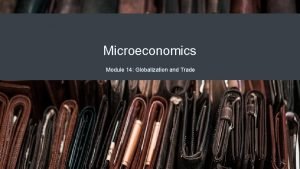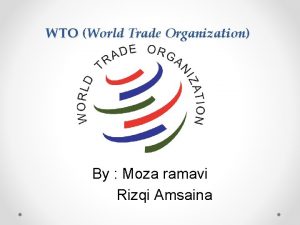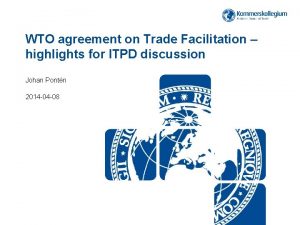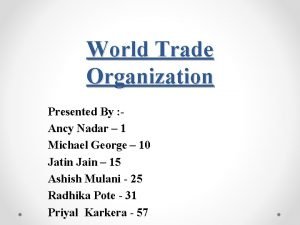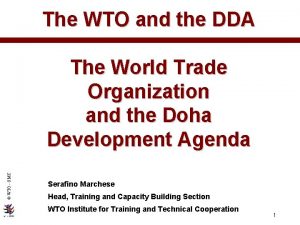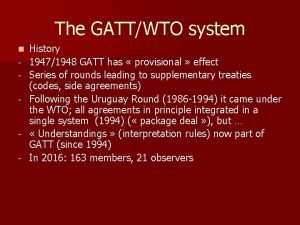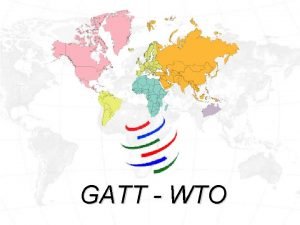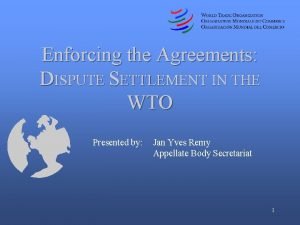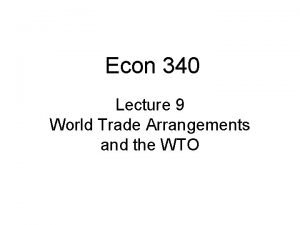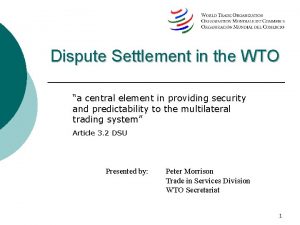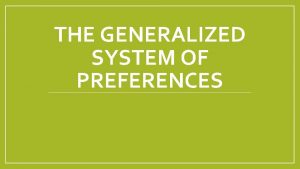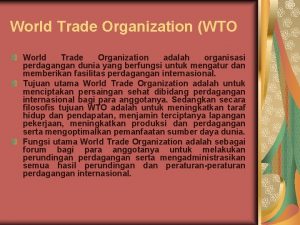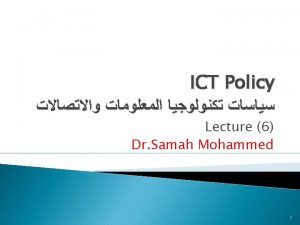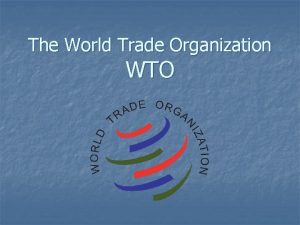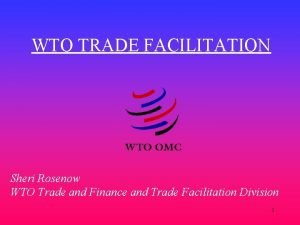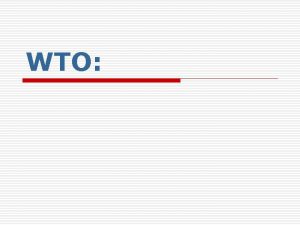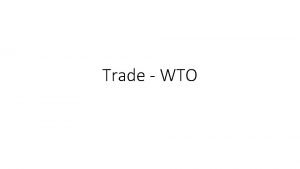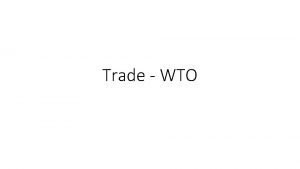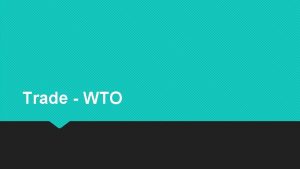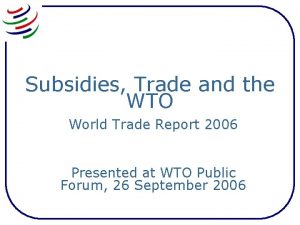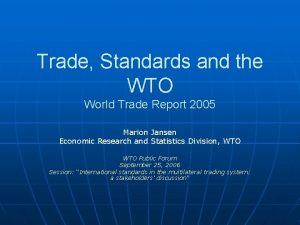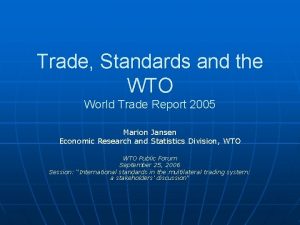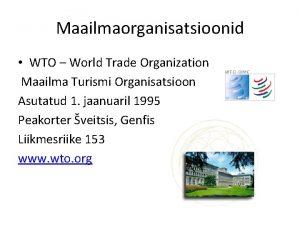WORLD TRADE ORGANIZATION WTO Simply put the World

















- Slides: 17

WORLD TRADE ORGANIZATION (WTO) Simply put: the World Trade Organization (WTO) deals with the rules of trade between nations at a global or near-global level. There are 153 countries in the WTO.

WHAT IS THE WTO? A set of rules … At its heart are the WTO agreements, negotiated and signed by the bulk of the world’s trading nations. These documents provide the legal ground-rules for international commerce. They are essentially contracts, binding governments to keep their trade policies within agreed limits _________________ … Essentially, the WTO is a place where member governments go to try to sort out the trade problems they face with each other.

PRINCIPLES OF THE WTO TRADING SYSTEM The WTO agreements are lengthy and complex because they are legal texts covering a wide range of activities. They deal with: agriculture, textiles and clothing, banking, telecommunications, government purchases, industrial standards and product safety, food sanitation regulations, intellectual property, and more.

PRINCIPLE 1: TRADE WITHOUT DISCRIMINATION A. Most-favored-nation (MFN) status: Under the WTO agreements, If you grant someone a special favor (such as a lower tariff duty rate for one of their products) then you have to do the same for all other WTO members. This principle is known as most-favored-nation (MFN) treatment. Some exceptions are allowed. countries can set up a free trade agreement that applies only to goods traded within the group — discriminating against goods from outside. Or they can give developing countries special access to their markets. Or a country can raise barriers against products that are considered to be traded unfairly from specific countries.

PRINCIPLE 1: CONTINUED B. National treatment: The same should apply to foreign and domestic services, and to foreign and local trademarks, copyrights and patents. National treatment only applies once a product, service or item of intellectual property has entered the market. Therefore, charging customs duty on an import is not a violation of national treatment even if locally-produced products are not charged an equivalent tax.

PRINCIPLE 2: FREER TRADE, GRADUALLY, THROUGH NEGOTIATION Lowering trade barriers is one of the most obvious means of encouraging trade. The barriers concerned include customs duties (or tariffs) and measures such as import bans or quotas that restrict quantities selectively History of Progression toward Free Trade: Since GATT’s creation in 1947– 1948 there have been eight rounds of trade negotiations. A ninth round, under the Doha Development Agenda, is now underway. At first these focused on lowering tariffs (customs duties) on imported goods. As a result of the negotiations, by the mid-1990 s industrial countries’ tariff rates on industrial goods had fallen steadily to less than 4% down from 20%

HISTORY CONTINUED By the 1980 s, the negotiations had expanded to cover non-tariff barriers on goods, and to the new areas such as services and intellectual property. Opening markets can be beneficial, but it also requires adjustment. The WTO agreements allow countries to introduce changes gradually, through “progressive liberalization”. Developing countries are usually given longer to fulfill their obligations.

PRINCIPLE 3: PREDICTABILITY Predictability “transparency”: With stability and predictability, investment is encouraged, jobs are created and consumers can fully enjoy the benefits of competition — choice and lower prices. The multilateral trading system is an attempt by governments to make the business environment stable and predictable. In the WTO, when countries agree to open their markets for goods or services, they “bind” their commitments.

The system tries to improve predictability and stability in other ways as well. One way is to discourage the use of quotas and other measures used to set limits on quantities of imports since administering quotas can lead to more red-tape and accusations of unfair play. Another is to make countries’ trade rules as clear and public (“transparent”) as possible. Many WTO agreements require governments to disclose their policies and practices publicly within the country or by notifying the WTO.

PRINCIPLE 4: PROMOTING FAIR COMPETITION The WTO is sometimes described as a “free trade” institution, but that is not entirely accurate. The system does allow tariffs and, in limited circumstances, other forms of protection. More accurately, it is a system of rules dedicated to open, fair and undistorted competition.

PRINCIPLE 5: ENCOURAGING DEVELOPMENT AND ECONOMIC REFORM The WTO system contributes to development. developing countries need flexibility in the time they take to implement the system’s agreements. WTO agreements allow for special assistance and trade concessions for developing countries. _______________________and countries in transition to market economies. Special “rounds” of negotiations aimed at helping these economies move forward.

THE DOHA ROUND (DOHA DEVELOPMENT AGREEMENT) The most recent round began in 2001—the Doha Round. Some key points of the Agenda: o Agriculture market access o Purpose is to establish a free and market-based trading system in world agriculture markets through reform. o Reform in the form of removing barriers such as tariffs; phasing out export subsidies; and reduction of other domestic support that distorts trade (tax policies, etc). o New regulations on food safety and security. o US position is to eliminate export subsidies within five years.

KEY POINTS-DOHA ROUND CONTINUED Market access for non-agricultural products Reduce “tariff escalation” How does Tariff escalation work? If a country wants to protect its processing or manufacturing industry, it can set low tariffs on imported materials used by the industry (cutting the industry’s costs) and set higher tariffs on finished products to protect the goods produced by the industry. This is “tariff escalation”. When importing countries escalate their tariffs in this way, they make it more difficult for countries producing raw materials to process and manufacture value added products for export. Tariff escalation exists in both developed and developing countries. Slowly, it is being phased out

KEY POINTS CONTINUED _____________________ Issues aimed at protecting innovation of new products and services but providing access to consumers Doha Agenda focuses on public health—promoting access to existing medicines and creation of new medicines while protecting patent owners. Allows governments to still enact own safety regulations to protect public health from harmful products/drugs. Re-visits parallel importing: A parallel import is

PARALLEL IMPORTING How does this work? Parallel imports are goods produced genuinely under protection of a trademark, patent, or copyright, placed into circulation in one market, and then imported into a second market without the authorization of the local owner of the intellectual property right Companies, either the manufacturer or the distributor, set different price points for their products in different markets. Parallel importers ordinarily purchase products in one country at a price (P 1) which is cheaper than the price at which they are sold in a second country (P 2) with permission of the property owner. The distributor imports the products into the second country, and sells the products in that country at a price which is usually between P 1 and P 2. They earn the profits; not the original owner of the idea or product.

EXAMPLE OF PARALLEL IMPORTING Example: Regulation of parallel importing in the pharmaceuticals area has become a critical issue in the global trading system. Advocates of strong international patent rights for new medicines support a global policy of banning parallel importing. However, public-health authorities in many countries argue that it is important to be able to purchase drugs from the cheapest sources possible, requiring an open regime of Parallel importing they argue that if such trade were widely allowed it would reduce profits in the research-intensive pharmaceutical sector and ultimately slow down innovation of new drugs. They argue that whether or not such imports actually occur, the threat they might come in could force distributors to charge lower prices. It is evident that policymakers in developing countries especially would place a higher weight on affordability of medicines than on promoting R&D abroad US is against parallel imports of pharmaceuticals along with Swiss (not surprising given the amount of pharmaceutical innovation in these two countries)

CRITICS OF THE WTO Some claim that the policies of the WTO are largely dictated by rich, industrialized nations, and actually widen the gap between the rich and poor countries. Some claim that industrialized nations have been allowed to keep artificially high tariffs in place on certain items, like clothing, keeping the less developed countries from accessing the rich markets. Industrialized countries maintain high tariffs on agriculture products, again limiting access to the developing world. The TRIPs agreement prohibits developing nations from using some technologies and products (such as medicines) from abroad—parallel importing Most WTO conferences are met with protestors in the street-some violent.
 Summarising is
Summarising is To put it simply
To put it simply Function of world trade organization
Function of world trade organization Functions of the world trade organization
Functions of the world trade organization World trade organization
World trade organization World trade organization
World trade organization Put out the light and put out the light
Put out the light and put out the light Put your left foot in
Put your left foot in Negara pendiri wto
Negara pendiri wto Organs of wto
Organs of wto Objectives of wto
Objectives of wto Objectives of wto
Objectives of wto Gatt+
Gatt+ Rundy gatt
Rundy gatt Wto dispute settlement mechanism
Wto dispute settlement mechanism Wto functions
Wto functions Function of wto
Function of wto Gsp wto
Gsp wto
